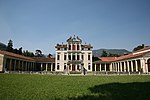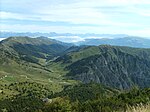Bassano del Grappa
Cities and towns in VenetoDomini di TerrafermaMunicipalities of the Province of VicenzaPages with Venetian IPAPopulated places established in the 2nd century BC

Bassano del Grappa (Venetian: Basan or Bassan, pronounced [baˈsaŋ]) is a city and comune, in the Vicenza province, in the region of Veneto, in northern Italy. It bounds the communes of Cassola, Marostica, Solagna, Pove del Grappa, Romano d'Ezzelino, Campolongo sul Brenta, Conco, Rosà, Cartigliano and Nove. Some neighbourhoods of these communes have become in practice a part of the urban area of Bassano, so that the population of the whole conurbation totals around 70,000 people. The 16th century painter Jacopo Bassano was born, worked, and died in Bassano, and took the town name as his own surname.
Excerpt from the Wikipedia article Bassano del Grappa (License: CC BY-SA 3.0, Authors, Images).Bassano del Grappa
Piazza Libertà,
Geographical coordinates (GPS) Address Nearby Places Show on map
Geographical coordinates (GPS)
| Latitude | Longitude |
|---|---|
| N 45.766666666667 ° | E 11.734166666667 ° |
Address
Piazza Libertà
Piazza Libertà
36061
Veneto, Italy
Open on Google Maps







